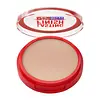Rimmel London Lasting Finish 25Hr Foundation SPF 20 Versus Rimmel London Lasting Finish 25h Compact Powder Foundation
What's inside
What's inside
 Key Ingredients
Key Ingredients

 Benefits
Benefits

No benefits
 Concerns
Concerns

 Ingredients Side-by-side
Ingredients Side-by-side

Water
Skin ConditioningCyclopentasiloxane
EmollientTalc
AbrasiveIsododecane
EmollientGlycerin
HumectantVinyl Dimethicone/Methicone Silsesquioxane Crosspolymer
Phenyl Trimethicone
Skin ConditioningPEG-10 Dimethicone
Skin ConditioningTrimethylsiloxysilicate
EmollientSodium Chloride
MaskingAmmonium Acrylates Copolymer
Phenoxyethanol
PreservativeDisteardimonium Hectorite
StabilisingPentylene Glycol
Skin ConditioningTriethoxycaprylylsilane
Chlorphenesin
AntimicrobialParfum
MaskingAlcohol Denat.
AntimicrobialAscorbyl Palmitate
AntioxidantCitric Acid
BufferingFructose
HumectantPropylene Carbonate
SolventSodium Hydroxide
BufferingTocopheryl Acetate
AntioxidantUrea
BufferingRetinyl Palmitate
Skin ConditioningDisodium Deceth-6 Sulfosuccinate
CleansingDisodium EDTA
Laureth-30
CleansingAllantoin
Skin ConditioningMaltose
MaskingSodium Lactate
BufferingSodium PCA
HumectantTrehalose
HumectantSodium Dehydroacetate
PreservativeBHT
AntioxidantGlucose
HumectantSodium Hyaluronate
HumectantTocopherol
AntioxidantTitanium Dioxide
Cosmetic ColorantIron Oxides
Water, Cyclopentasiloxane, Talc, Isododecane, Glycerin, Vinyl Dimethicone/Methicone Silsesquioxane Crosspolymer, Phenyl Trimethicone, PEG-10 Dimethicone, Trimethylsiloxysilicate, Sodium Chloride, Ammonium Acrylates Copolymer, Phenoxyethanol, Disteardimonium Hectorite, Pentylene Glycol, Triethoxycaprylylsilane, Chlorphenesin, Parfum, Alcohol Denat., Ascorbyl Palmitate, Citric Acid, Fructose, Propylene Carbonate, Sodium Hydroxide, Tocopheryl Acetate, Urea, Retinyl Palmitate, Disodium Deceth-6 Sulfosuccinate, Disodium EDTA, Laureth-30, Allantoin, Maltose, Sodium Lactate, Sodium PCA, Trehalose, Sodium Dehydroacetate, BHT, Glucose, Sodium Hyaluronate, Tocopherol, Titanium Dioxide, Iron Oxides
Ingredients Explained
These ingredients are found in both products.
Ingredients higher up in an ingredient list are typically present in a larger amount.
BHT is a synthetic antioxidant and preservative.
As an antioxidant, it helps your body fight off free-radicals. Free-radicals are molecules that may damage your skin cells.
As a preservative, it is used to stabilize products and prevent them from degrading. Specifically, BHT prevents degradation from oxidation.
The concerns related to BHT come from oral studies; this ingredient is currently allowed for use by both the FDA and EU.
However, it was recently restricted for use in the UK as of April 2024.
Learn more about BHTPhenoxyethanol is a preservative that has germicide, antimicrobial, and aromatic properties. Studies show that phenoxyethanol can prevent microbial growth. By itself, it has a scent that is similar to that of a rose.
It's often used in formulations along with Caprylyl Glycol to preserve the shelf life of products.
This ingredient is a preservative with antimicrobial properties. It is the sodium salt of dehydroacetic acid.
It is especially effective at preventing bacterial and fungal growth in low concentrations.
Talc is a clay mineral. It helps absorb moisture and improve the texture of products. Like other types of clay, Talc can have a slight exfoliating effect on skin. Talc can be added to increase the volume of products.
Some Baby powders are made by combining talc with corn starch. The word "talc" comes from Latin and originates from Arabic. Talc is a mineral commonly found throughout the world.
If you have any concerns about using talc, we recommend checking out the FDA's official page.
Learn more about TalcTitanium dioxide is a mineral UV filter widely used in sunscreens and cosmetics.
It is one of only two UV filters officially classified as “mineral” by regulatory agencies, the other being zinc oxide.
Titanium dioxide provides broad-spectrum protection mostly in the UVB and UVAII range, with some protection in the UVAI range.
While its UVA protection isn’t as strong as zinc oxide’s, the difference is minor.
A common myth is that mineral UV filters reflect UV light. However, modern research shows titanium dioxide absorbs UV radiation like chemical filters (~95% absorption & 5% reflection).
Thanks to its non-irritating nature, titanium dioxide is suitable for sensitive, acne-prone, or redness-prone skin. It is unlikely to cause "eye sting" like other sunscreen ingredients.
A major drawback of this ingredient is its white cast and thick texture. This is why mineral sunscreens often leave a white cast and are less cosmetically elegant than chemical/hybrid sunscreens.
To improve white cast and spreadability, micronized or nano-sized titanium dioxide is often used.
There are ongoing concerns surrounding nano-titanium oxide's impact on marine ecosystems.
There is no conclusive evidence that any form of titanium oxide (or any other sunscreen ingredients) will cause harm to marine ecosystems or coral reefs. The science is still developing but many consumers are keeping a close eye on this issue.
Please note, many destinations have reef-safety sunscreen rules. For instance, the U.S. Virgin Islands advises all visitors to use non-nano mineral sunscreens.
Nano mineral sunscreens once raised safety concerns about absorption into skin.
Extensive research has shown that they do not penetrate healthy or damaged skin; they remain safely on the surface and the top layer of dead skin (stratum corneum).
You'll likely find titanium dioxide bundled with alumina, silica, or dimethicone. These ingredients help make titanium dioxide highly photostable; this prevents it from interacting with other formula components under UV light.
Learn more about Titanium DioxideWater. It's the most common cosmetic ingredient of all. You'll usually see it at the top of ingredient lists, meaning that it makes up the largest part of the product.
So why is it so popular? Water most often acts as a solvent - this means that it helps dissolve other ingredients into the formulation.
You'll also recognize water as that liquid we all need to stay alive. If you see this, drink a glass of water. Stay hydrated!
Learn more about WaterThis ingredient is a combination of red, black, and yellow iron oxide pigments. This combination of colors is usually found in foundation, because it results in a "skin" color.